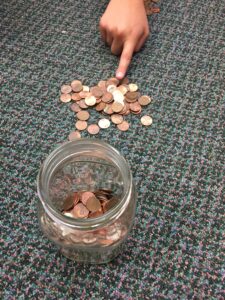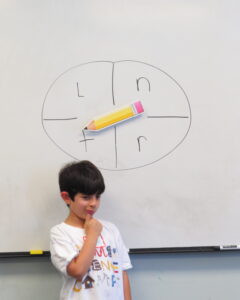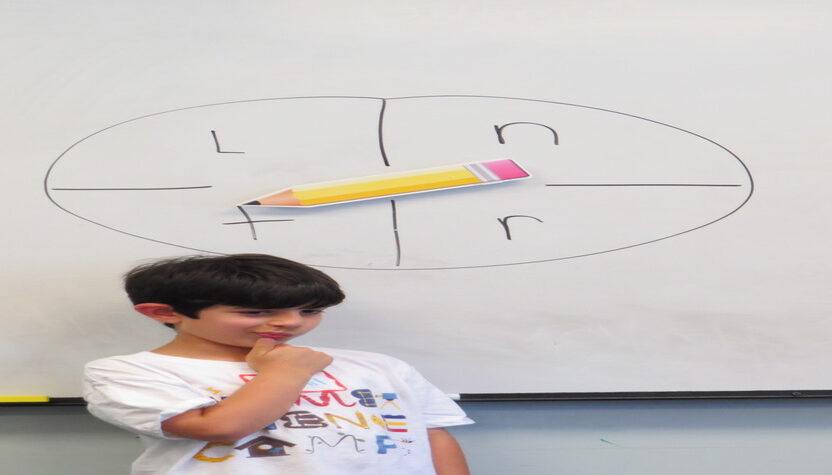These 6 simple talking games are quick, easy and fun to play! They engage groups of students quickly. In fact, I find that almost anytime I put a child in front of the classroom, the whole group listens easily and well. See the little guy at the front of this group?! He has captivated his entire audience through one of these super simple talking games!

6 Simple Talking Games
Additionally, these talking games require very few, if any, materials and don’t need a lot of time to play. Each talking game can be kept short or stretched out according to the time you have. Lastly, the talking games can be used with almost any language! This post will cover the following 6 talking games that you truly won’t want to miss!
- Answer Questions
- The Penny Game
- Brainstorm. Erase. Guess.
- Fill in the blank.
- Spin. Describe. Guess.
- Kids Tell Stories-True or Tale?
1. Answer.Question-The Speaking Version
You state an answer. Students ask a question. The technicality of the game is what creates lots of laughs! Moreover, it’s excellent for language learners and helps children of all ages, levels and abilities solidify their English skills.

Common Core State Standards
NOTE: This lesson can address the following Common Core Standards: CCSS.ELA-LITERACY.SL.1.6, SL.2.6, SL.3.6, SL.4.6, SL.5.6
How to Play!
- First, for large groups, divide the students into 2 groups. For smaller groups, simply have each child take a turn.
- Second, explain to the group that you are going to say an answer.
- Then, tell the students that they have to ask a question that can fit perfectly with the answer. “How are you?” fits with “Fine, thanks.”

However, it gets tricky when the answer is:

For example, “Where are you?” doesn’t work because “at the store” would be the response to that. On the other hand, a correct question that does work is, “to the store” would be “Where are you going?”
The fact that it gets technical is what makes it fun! When a student shouts a question that doesn’t work, I smile and shake my head no. Often, they’ll laugh in their attempt to try again.
Print the Instructions
Here, you can print the instructions. Note, I don’t never use all of the answers listed at one time. There’s a long list so you and I have a wide variety to choose from. Lastly, this game is a great lead in to playing Answer.Question-The Writing Version.
We almost always play this game after writing a letter or comic such as the guided writing lessons below:

Friendly Letter About a Unique Pet



Fun Park or Place-Suggestion Letter

2. The Penny Game

Next, is The Penny Game. This talking game is a winner every time! Returning students remember it and ask for it. Furthermore, it’s a game that can be played using any theme and to fit any language level or skill. In essence, students see how many pennies they can earn in 60 seconds by naming a list of words or facts that they are learning.
Common Core State Standards
NOTE: This lesson can address the following Common Core Standards: CCSS.ELA-LITERACY.RF.K.2.A, RF.1.2.A, RF.2.3.A, RI.K.2, RI.1.2 and RI.2.2.
Setting up the Game
First, the Penny Game works best for smaller groups (up to 12). All you need is a jar full of pennies.

Next, a group of students sits in a circle on the floor.

Then, each child has 60 seconds to rattle off as many facts as they can about a given animal or topic, or say as many vocabulary words that they are learning. They get a slide and keep a penny for each word or fact. The Penny Game serves as a tangible way to celebrate what students have learned in any given lesson or unit. Samples of topics include:
- Words that start with P
- Rhyming words
- Farm animal names
- Animals in the rainforest
- Names of cities, capitols, states or countries
- Verbs ending in ED
- Instead of Said words
- Facts about lemurs
Now to play!
First, determine which topic you will be covering for the game. Then, pour out a pile of pennies on to the floor in front of the first student. Next, set the timer for 1 minute on a timer or your phone.

Finally, say “Go!” and start the timer. The first child slides a penny from the pile to him or herself every time he/she states a fact or names a vocabulary word.


As soon as the timer sounds, the player stops speaking and keeps the pennies he/she has earned.
Here are the game instructions for you to print and use.
We consistently play the penny game after the following writing prompts:
The Penny President-Non-Fiction: naming facts about Abraham Lincoln

Packing–A List Poem: naming things to pack

All Wild Cats Writing Prompts: naming facts that the students learned

NOTE: Every now and then, I have a child who has been taught not to receive money from people. This child will either opt to not play, or will play by simply stating facts and not receiving the pennies. I always respect this situation fully when it comes up.
3. Brainstorm. Erase. Guess.
Among all of the simple talking games, this one is probably the easiest and quiets a room EVERY TIME we play! Additionally, it’s a great game for building or reviewing vocabulary!
How to Play!
- First, choose a topic. Then, students brainstorm a list of words that fit that specific category (types of flowers, ice cream flavors, types of cars, vegetables, words that start with ch, Science, History, Math terms, what have you!)
- Next, write the responses on a whiteboard, chalkboard or Smart Board at the front of the room. Add your own words to the list to help the students learn new words that they’re not thinking of or have forgotten.
- NOTE: If you have time, you can play Word Scramblers at this point, using the list of words on the board. This gives the students a chance to practice spelling the words and helps solidify the list of words in their memory. It’s important to leave the words up while you play!!!
- Last, have all of the students close their eyes while you erase one word from the list.


6. Sixth, have the students open their eyes. They try to guess which word you erased. Be sure and choose a student who is seated quietly with his or her hand up.

If a classmate is loud, he or she can’t be called. This is a natural way to maintain a healthy class order so that the game can be fully enjoyed. I can’t recall any time that I’ve had trouble with kids cooperating for play this game. They just like it every time!
7. Last, whichever student guesses the word correctly gets to erase the next word! Continue to play until all of the words are erased or the allotted time runs out!
Here are the instructions for you to print out and use.
We played this game after the following writing prompts:
The Never-Ending Syrup Sundae-Instructions using ice cream flavors

10 Black Spiders-Rhyme using spider names

4. Fill in the Blank
This game is fast and fun! Divide the group of children into two groups, a left side and a right side. This particular group was small, so we sat on the floor.

Here’s how you play!
- First, one child from each group stands up.
- Second, you begin a phrase from the list.
- Third, the two children race to fill in the blank with any word that makes sense!

4. Fourth, they sit and the next two students stand. It’s meant to move quickly and often gets fun and silly!
Note, you don’t need to go through the entire list. Play according to the time you have. There are no points, no wins. Just fun! This game can go along with ANY writing prompt. It’s simply a fast, short, sweet, fun game to play anytime!
If you’re working on rhyme you can play Fill in the Blank Rhyme which gets hysterical! It goes well with the Calendar Page-couplets and quatrains writing prompt.

Print the Instructions
Here are the instructions and sentences for you to print out and use.
5. Spin-Describe-Guess

The unusual challenge of this game gets the chuckles going! This game forces students to think beyond the words that they normally choose and use.
In order to play this game, you’ll need one magnetic spinner*. If you haven’t read my full post on the winner spinner, you won’t want to miss it! It gives you a long list of game ideas that are so easy to run and super fun for the kids. Check out the full post here. These magnetic spinners are so worth it!
Common Core State Standards
This game can also address the following Common Core Standards: CCSS.ELA-LITERACY.SL.K.4, SL.1.4, SL.3.4, SL.4.4 and SL.5.4.
Setting Up the Game
First, draw a circle on the white board, chalkboard or smart board. Divide the circle into 4 sections. Fill the sections with the letters n, l, r, t and place the spinner in the middle. Certainly, you can use any letters that you want. These are the letters that I use most often.

Next, explain to the students that they can describe ANY word. In other words, the word that they are describing can be ANYTHING.
The Prohibited Letter
However, the words that they USE to describe their word CANNOT have the letter that they have spun. For example, in the following image the student can’t use words that have the letter “t” in them to describe his chosen word.

This is confusing in the very beginning. But once the game gets going, the kids love it. As a result, it challenges the speaker to think outside the box, to use other words than what he or she would normally use!
HOW TO PLAY!
- First, one student stands at the front of the group.
- Second, he/she describes a word that coincides with the topic that’s discussed that day (a place, a person, movie, brand name etc.)
- Third, the student has to say at least 3 sentences before players can guess.
- Fourth, the student chooses a student who is seated, quiet and has his/her hand up to guess

5. Fifth, whichever student guesses correctly, takes the next turn.
Print the instructions, or the activity sheet.
We’ve played this game after the following writing prompts:
Hot Tamales!-Journal (describing candies)

Never Ending Syrup Sundae-Instructions (describing ice cream flavors)

Festive Food-Personal Narrative (describing foods)

Exploration-an imaginary personal narrative (describing places)

6. Kids Tell Stories-True or Tale?
Kids love to tell stories! I was surprised at how good the kids were at this game and how long their stories got. They rattled off great stories and their peer listeners LOVED IT! We almost always play this game after a personal narrative writing prompt.
Common Core State Standards
Note: This game can address the following Common Core State Standards: CCSS.ELA-LITERACY.SL.2.4, SL.3.4 and SL.4.4,
This game is so simple, so fun and can really quiet a group at the end of a long day.
Here it goes:
- First, a student stands at the front of the group.
- Second, he/she tells a story about him/herself. The story can be completely true, partially true or completely false.
- Third, the students who are listening have to guess whether or not the story is a tale (only partially true or completely fasle) or truth (completely true). That’s it! So simple. So fun!

Writing Prompts
We play this simple talking game after the following writing prompts:

Dance at Grandpa’s-A Descriptive Family Event

Birthday Party-Personal Narrative


Festive Food-Personal Narrative

Short Video
Take this game a step further and share this short 3 minute video of kids telling stories.
These simple talking games delight students and relieve teachers. Give one, some or all of them a try!
